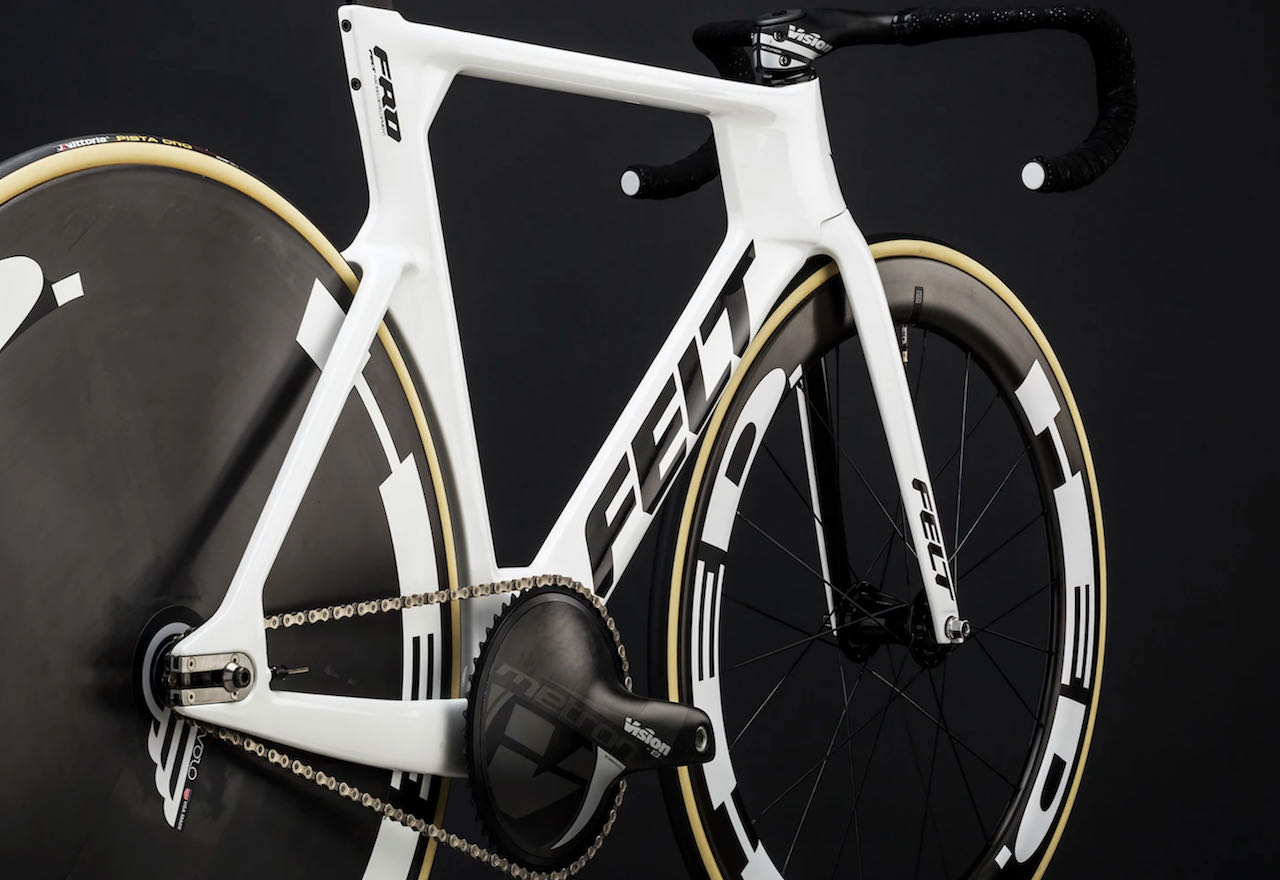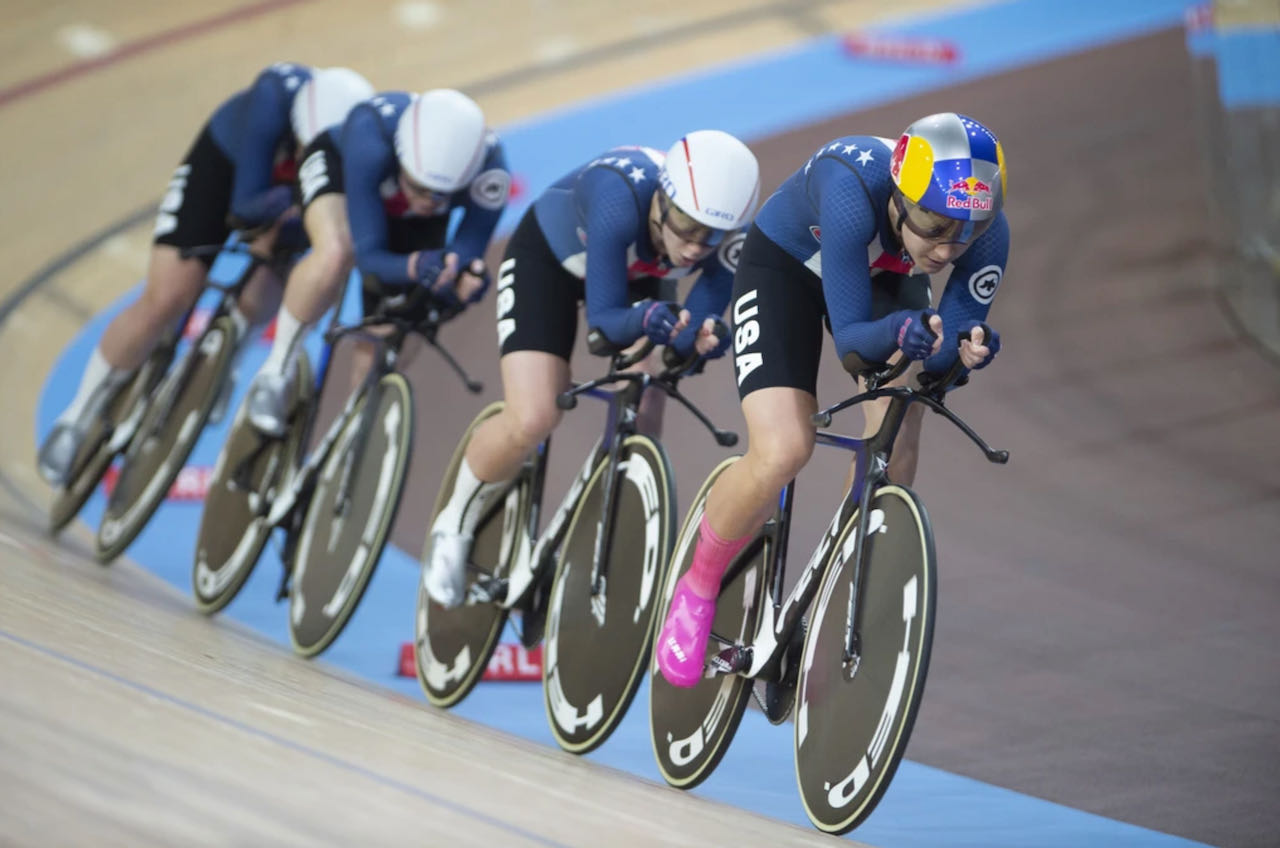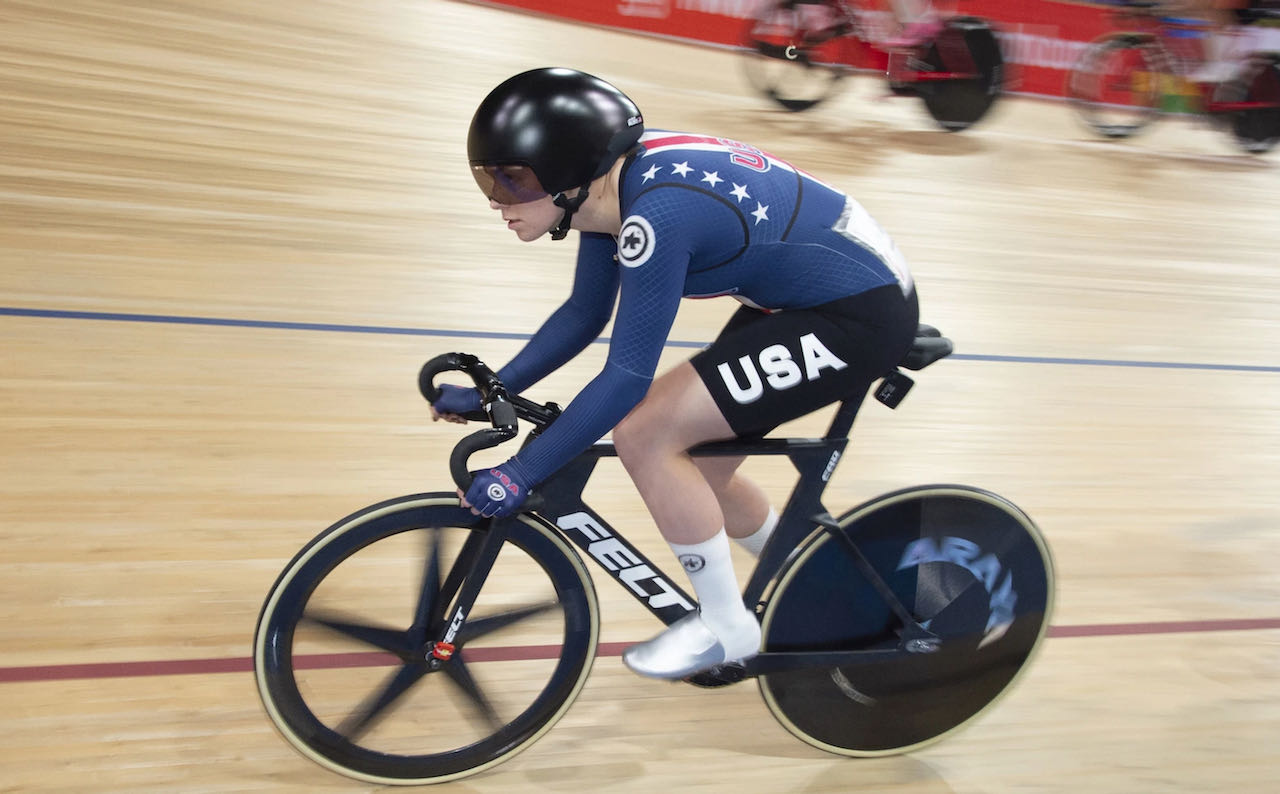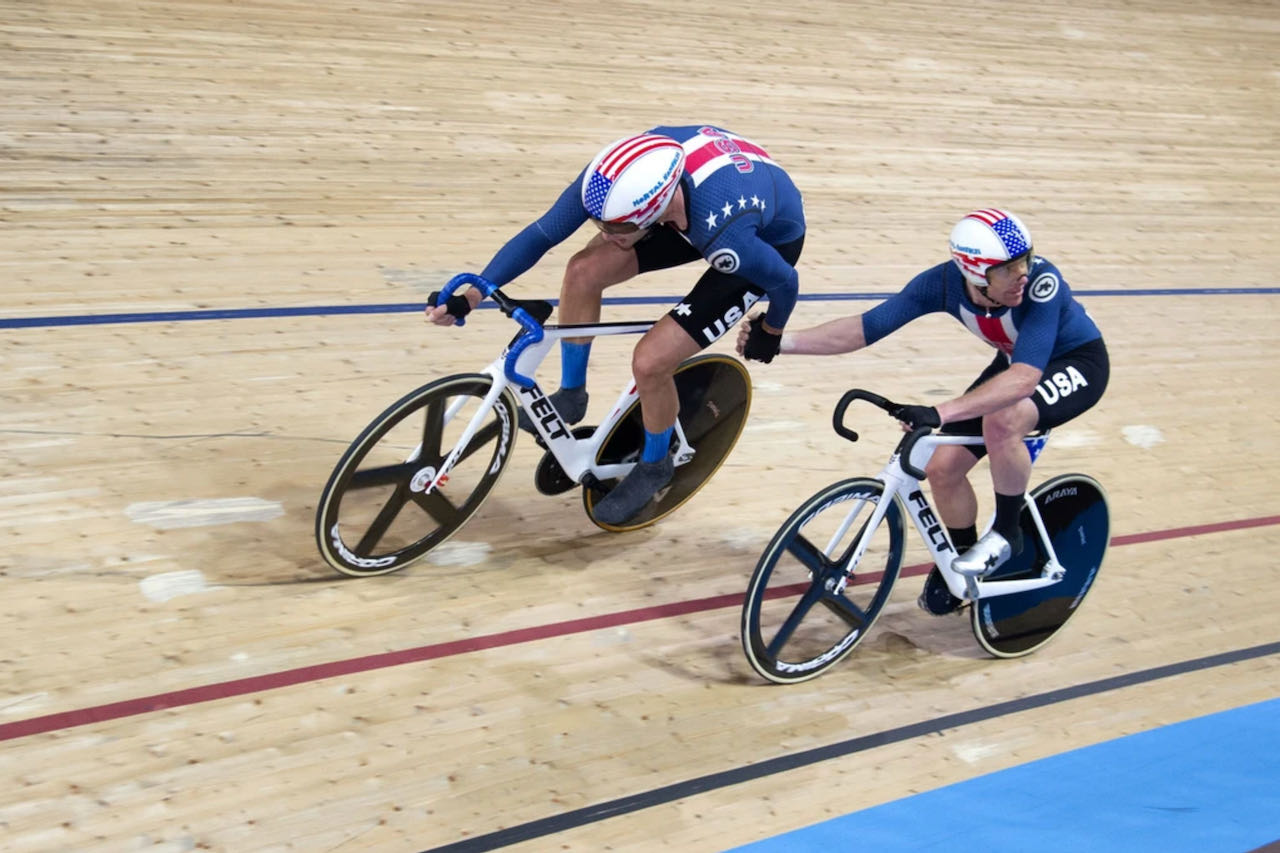The track bike discipline is a bit different than the other cycling events at the Tokyo Olympics 2021. These aren’t the skinny-jeans-&-Chrome-bag-style track bikes you’ll see in front of Whole Foods. These are carbon fiber aero machines with fast, high torque maniacs racing around a wooden track with no brakes.

Sound exciting? It is, and there are many different disciplines that you can watch during Tokyo Olympics 2021. Actually — Track dominates the cycling program at an Olympics with 12 out of 22 events.
The history of Olympic track cycling dates back over 120 years, with its first appearance coming at the Athens 1896 Games. It has been part of the Olympic sports program ever since, (except for Stockholm 1912). However, women’s track cycling didn’t make its Olympic debut in Seoul in 1988.
Olympic Track cycling equipment
The UCI and regulating bodies strictly enforce what riders can and can’t use on the track. Loads of engineering and aerodynamic testing go into every new bike. Felt even went as far as moving the crankset from the right to the left side of the bike itself on the TA FRD bike first made for the Rio Olympics. Because these races are decided on fractions of a second, and aero is everything.

When we say no brakes, we mean no brakes — the bikes the track racers use are single-speed and fixed gear. Meaning the bike has no freewheel like bikes on the road or mountain — no coasting allowed. Riders choose their gearing based on the event’s discipline and fitness. Mind you — these riders have to spin up the massive gear at the start and then keep it rolling with fantastic cadence to keep control.
This year, Felt Introduced a new Track focused tool in the form of the TK FRD. Different from the TA FRD, the TK is meant for mass-start and sprint disciplines where aerobars are shunned in favor of more traditional drop bars.
What is the velodrome?
The nice thing about the track is that they are the same wooden constructed banked tracks every time, though each has its own feel and speed. They’re also usually indoors, or at least covered since the wooden surface does not mix well with the elements.

The track is 250m in length and banked to 45 degrees at the highest. The Izu Velodrome is where the action will take place for the Tokyo Olympics is located in Izu City, Shizuoka Prefecture – right in the Sports Center, about 120km away from Tokyo proper.
Different disciplines of Olympic Track Cycling
There are six different disciplines this year at the Tokyo Olympics — this means there are 12 gold medals for the taking — but only if you have what it takes.

Felt’s Ultimate Guide to Track Cycling events in Tokyo
Felt Bicycles has positioned itself as the U.S. expert in track racing, and they put together a fantastic guide to track cycling disciplines which they’ve allowed us to repost below. Hit up their blog for more posts that dive into the world of track racing. Check out the bike Team USA will be riding here.
Team Sprint
As its name implies, the Team Sprint is a variation on the Sprint event that showcases teams of three riders going head-to-head against one another. Each team begins from a standing start on opposite sides of the track, and they race for a distance of three laps. Once the race starts, a team’s three riders will quickly get into a paceline formation. The front rider will peel off after the first lap. Then the remaining two riders will continue sprinting. At the end of the second lap, the lead rider will pull off, leaving the last remaining rider to complete the final lap. Whichever team’s final rider crosses the finish line first is the winner. At the highest levels of the Team Sprint competition, typical finishing times for a race are around 45 seconds, and riders will get up to speeds of about 40 mph / 64 kph. Regarding the women’s competition for the Team Sprint, the format utilizes teams of two riders sprinting over two laps instead of three riders over three laps for the men.
Sprint
The Sprint may very well be the purest form of bike racing. Two riders compete in a series of head-to-head races over three laps of the velodrome (also referred to as a “match”). The two riders start next to each other from a standing start. The first rider to cross the finish line wins the race, and the rider who wins the best of three races wins the match. Riders who qualify for this event are placed into a knockout format, with the winner of each round advancing to face a new opponent. As the name implies, the Sprint is a fast and furious test of a rider’s explosive power. But, tactics also come into play quite often. Spectators will often see one or both competitors ride slowly during the first lap or two in an attempt to conserve a bit of energy and force their opponent to make the first move, thereby “leading out” the sprint—which can often give an advantage to the other rider thanks to a slight aerodynamic draft. Because the Sprint demands explosive power and exceptional handling skills from the riders, bikes like the all-new FELT TK FRD are optimal.
Keirin
The Keirin event originated in Japan, where track cycling is incredibly popular. It’s a mass-start event that sees a group of six riders lines up next to each other along the start line. Men’s events are contested over eight total laps, while the women’s Keirin is contested over six complete laps. The race kicks off when an official riding a pace bike (often a motorized scooter or electric bicycle) rides past the start line. The competitors will then launch from a standing start and settle into a paceline formation behind the official pace bike. The riders must stay behind the pace bike, which will gradually increase its speed up to around 45-50 kph. When there are two and a half laps remaining in the race, the pace bike will peel off and out of the way, leaving the riders to sprint directly against one another towards the finish line. What makes the Keirin exciting is that sometimes there will be a full sprint between all the riders over those remaining two and a half laps, and sometimes there may be some tactics employed as riders may not wish to begin their sprints immediately, instead of trying to coax their rivals into leading them out.

Team Pursuit
The Team Pursuit is the ultimate test of teamwork, focus, and grit. Two teams of four riders compete head-to-head over a distance of four kilometers (16 laps of a velodrome). Each team starts on opposite sides of the track, utilizing a standing start method—which means each rider will need to use all of their strength to quickly get up to speed. Each team will then quickly merge into a paceline formation, with the riders settling into a single-file line. The teams will then chase, or “pursue,” one another, with each team rotating riders off the front to spread out the workload and maximize the complete team’s effort (just like in a paceline on a road ride). If one team successfully catches up to the other team in a race for a medal, then they are victorious and the race is over. If this happens during a classification round when all teams must post their fastest time to qualify or be seeded into subsequent rounds, then the rules dictate that the “caught” team must ensure that they do not impede the faster team in the safest manner possible.
More commonly, one team will not catch another, and the winning team is the one that posted the fastest time. It’s also important to know that a team’s official time is counted when the third rider of the team crosses the finish line. Because of this rule, it’s common to see teams employ a tactic of having one rider take a longer pull on the front to expend all of their energy and then safely and slowly move out of the way, so that their teammates can more efficiently complete the remaining laps. Because of the high speeds and aerodynamic efficiency required to post the fastest time possible, team pursuit squads will utilize aerodynamically-optimized bikes with aerobars and aggressive riding positions—such as the TA FRD ridden by the members of the USA Cycling track program.

Omnium
The Omnium is a competition for individual riders and consists of a medley of four unique mass-start races. Riders receive points based on their results in each race, and the rider with the most cumulative points after all four racers is the winner. In each race, the winner receives 40 points; second place receives 38, third place receives 36, and so on. The entire Omnium competition will take place over the course of a day. Here are the four events that will make up the Omnium in Tokyo:
- Scratch Race
Held over 15 km for the men and 10 km for the women, the Scratch race is a straightforward affair that sees points being awarded to the top finishers who cross the finish line first after the total race distance. The Scratch race begins with a neutral first lap to allow all of the riders to get up to speed. - Tempo Race: This race is held over 10 km (40 laps) for men and 7.5 km (30 laps) for women. After the first four laps of the race, officials begin awarding one point to the rider who crosses the finish line first at the end of each lap. Any rider who laps the field gains a massive 20 points, while riders can lose 20 points if they’re lapped by the main field. The rider with the most points wins the Tempo Race and is then awarded a different set of points based on the Omnium scoring system.
- Elimination Race
Another mass-start event that is relatively straightforward, the Elimination race sees all of the riders start together. After a neutral lap for everyone to get up to speed, the race is on. Every two laps, the last-placed rider is eliminated from the race. This continues until there is only one rider left, who is the winner. - Points Race: Held over 25 km for the men and 20 km for the women, the Points Race features a sprint for points every 10 laps. The top four riders in each sprint score point —5 points for the first-placed rider, 3 points for second, 2 points for third, and 1 point for fourth—and the last sprint to cap off the race scores double. This is similar to the Madison event in scoring. Lapping the field will earn a racer an additional 20 points.

Madison
The Madison may very well be the most unique event in all of track cycling. Named for New York City’s Madison Square Garden arena where the event first gained popularity in the early days of track racing, the Madison is a complex team event that consists of two riders per team racing against several other teams at the same time, with each team attempting to score points at various points in the race. This summer’s competition in Tokyo will feature a women’s Madison event for the first time in the competition’s history. For the men’s event, the race is 50 kilometers long (200 laps of the velodrome), and the women’s is 30 kilometers (120 laps). Every 10 laps, teams will sprint to the finish line to accumulate points—5 points for the first team, 3 points for the second team, 2 points for the third team, and 1 point for the fourth team. Points awarded in the final sprint at the very end of the race are doubled. Teams can also earn a bonus 20 points if they lap the field and join the rear of the main pack of riders.
Only one member of each two-person team is active in the race at any given time. The other team member circles the track along the upper, or outer, section to rest between their sprints. When it comes time to swap places, team members must physically touch one another, which is most commonly done via a maneuver where the two riders will grasp hands and the active rider will “slingshot” the other rider forward to add a burst of acceleration. The team that completes the most laps is the winner, with the points standings deciding the winner if more than one team finishes the entire race without being lapped.
Olympic Track Cycling Tokyo 2021 – Who to watch
Considering the cancellation of track worlds this year, no one can say who will come out on top. We do know the teams that are always dialed for perfection though; Team USA is looking good, especially with Chloe Dygert leading the charge for the women. The G.B. squad and the Dutch men all have what it takes for a gold medal effort.
Men’s and Women’s Cycle Track
Australia
Ashlee Ankudinoff
- Women’s Team Pursuit
Georgia Baker
- Women’s Team Pursuit
- Women’s Madison
Annette Edmondons
- Women’s Omnium
- Women’s Team Pursuit
- Women’s Madison
Matthew Glaetzer
- Men’s Team Sprint
- Men’s Sprint
- Men’s Keirin
Nathan Hart
- Men’s Team Sprint
- Men’s Sprint
Leigh Howard
- Men’s Team Sprint
- Men’s Madison
Alexandra Many
- Women’s Team Pursuit
Kaarle McCulloch
- Women’s Sprint
- Women’s Keirin
Kelland O’Brien
- Men’s Madison
Lucas Plapp
- Men’s Team Pursuit
Alexander Porter
- Men’s Team Pursuit
Matthew Richardson
- Men’s Team Sprint
- Men’s Keirin
Sam Welsford
- Men’s Team Pursuit
- Men’s Omnium
Austria
Andreas Graf
- Men’s Madison
Andrease Mueller
- Men’s Omnium
- Men’s Madison
Belarus
Yauheni Karaliok
- Men’s Omnium
Tatsiana Sharakova
- Women’s Omnium
Belgium
Jolien D’Hoore
- Women’s Madison
Kenny de Ketele
- Men’s Omnium
- Men’s Madison
Robbe Ghys
- Men’s Madison
Lotte Kopecky
- Women’s Omnium
- Women’s Madison
Canada
Hugo Barrette
- Men’s Sprint
- Men’s Keirin
Allison Beveridge
- Women’s Omnium
Ariane Bonhommme
- Women’s Team Pursuit
Vincent de Haitre
- Men’s Team Pursuit
Jasmin Duehring
- Women’s Team Pursuit
Michael Foley
- Men’s Team Pursuit
- Men’s Madison
Annie Foreman-Mackey
- Women’s Team Pursuit
Derek Gee
- Men’s Team Pursuit
- Men’s Madison
Lauriane Genest
- Women’s Sprint
- Women’s Keirin
Jay Lamoureux
- Men’s Team Pursuit
Kelsey Mitchell
- Women’s Sprint
- Women’s Keirin
Georgia Simmerling
- Women’s Team Pursuit
Nick Wammes
- Men’s Sprint
- Men’s Keirin
Peoples Republic of China
Shanju Bao
- Women’s Team Sprint
- Women’s Sprint
- Women’s Keirin
Jiali Liu
- Women’s Omnium
Xu Chao
- Men’s Sprint
- Men’s Keirin
Tianshi Zhong
- No Info
Colombia
Kevin Santiago Quintero Chavarro
- Men’s Sprint
- Men’s Keirin
Czech Republic
Tomas Babek
- Men’s Sprint
- Men’s Keirin
Denmark
Amalie Dideriksen
- Women’s Omnium
- Women’s Madison
Norman Lasse Hansen
- Men’s Team Pursuit
- Men’s Madison
Julius Johansen
- Men’s Team Pursuit
Niklas Larsen
- Men’s Omnium
- Men’s Madison
Julie Leth
- Women’s Madison
Frederik Madsen
- Men’s Team Pursuit
Rasmus Pedersen
- Men’s Team Pursuit
Egypt
Ebtissam Ahmed Zayed
- Women’s Omnium
France
Victoire Berteau
- Women’s Team Pursuit
Marion Borras
- Women’s Team Pursuit
Clara Copponi
- Women’s Omnium
- Women’s Madison
Coralie Demay
- Women’s Sprint
- Women’s Keirin
Fortin Valetine
- Women’s Team Pursuit
Florian Grengbo
- Men’s Team Sprint
Donavan Grondin
- Men’s Madison
Mathilde Gros
- Women’s Sprint
- Women’s Keirin
Rayan Helal
- Men’s Team Sprint
- Men’s Sprint
- Men’s Keirin
Marie le Net
- Women’s Team Pursuit
- Women’s Madison
Benjamin Thomas
- Men’s Omnium
- Men’s Madison
Sebastien Vigier
- Men’s Team Sprint
- Men’s Sprint
- Men’s Keirin
Germany
Timo Bichler
- Men’s Team Sprint
Stefan Motticher
- Men’s Team Sprint
- Men’s Sprint
- Men’s Keirin
Franziska Brausse
- Women’s Team Pursuit
- Women’s Madison
Sophie Lea Friedrich
- Women’s Team Sprint
- Women’s Sprint
- Women’s Keirin
Felix Gross
- Men’s Team Pursuit
Emma Hinze
- Women’s Team Sprint
- Women’s Sprint
- Women’s Keirin
Lisa Klein
- Women’s Team Pursuit
- Women’s Madison
Roger Kluge
- Men’s Omnium
- Men’s Madison
Mieke Kroger
- Women’s Team Pursuit
Maximilian Levy
- Men’s Team Sprint
- Men’s Sprint
- Men’s Keirin
Theo Reinhardt
- Men’s Team Pursuit
- Men’s Madison
Leon Rohde
- Men’s Team Pursuit
Laura Suessemilch
- Women’s Team Pursuit
Domenic Weinstein
- Men’s Team Pursuit
Great Britian
Katie Archibald
- Women’s Team Pursuit
- Women’s Madison
Elinor Barker
- Women’s Team Pursuit
Jack Carlin
- Men’s Sprint
- Men’s Keirin
- Men’s Team Sprint
Edward Clancy
- Men’s Team Pursuit
Neah Evans
- Women’s Team Pursuit
Ethan Hater
- Men’s Team Pursuit
- Men’s Madison
Jason Kenny
- Men’s Sprint
- Men’s Keirin
- Men’s Team Sprint
Laura Kenny
- Women’s Omnium
- Women’s Madison
Josie Knight
- Women’s Team Pursuit
Katy Marchant
- Women’s Sprint
- Women’s Keirin
Ryan Owens
- Men’s Team Sprint
Ethan Vernon
- Men’s Team Pursuit
Matthew Walls
- Men’s Omnium
- Men’s Madison
Oliver Wood
- Men’s Team Pursuit
Greece
Christos Volikakis
- Men’s Omnium
Hong Kong, China
Jessica Yan Hoi Lee
- Women’s Sprint
- Women’s Keirin
Sze Wai Lee
- Women’s Sprint
- Women’s Keirin
Yee Bo Leung
- Women’s Madison
Yao Pang
- Women’s Omnium
- Women’s Madison
Ireland
Mark Downey
- Men’s Omnium
- Men’s Madison
Felix English
- Men’s Madison
Emily Kay
- Women’s Omnium
- Women’s Madison
Shannon McCurley
- Women’s Madison
Italy
Martina Alzini
- Women’s Team Pursuit
Elisa Balsamo
- Women’s Team Pursuit
- Women’s Madison
Rachele Barbieri
- Women’s Team Pursuit
Simone Consonni
- Men’s Team Pursuit
- Men’s Madison
Filippo Ganna
- Men’s Team Pursuit
Vittoria Guazzini
- Women’s Team Pursuit
Francesco Lamon
- Men’s Team Pursuit
Jonathan Milan
- Men’s Team Pursuit
Letizia Paternoster
- Women’s Omnium
- Women’s Madison
Elia Viviani
- Men’s Omnium
- Men’s Madison
Japan
Eiya Hashimoto
- Men’s Omnium
Yumi Kajihara
- Women’s Omnium
- Women’s Madison
Yuka Kobayashi
- Women’s Sprint
- Women’s Keirin
Kisato Nakamura
- Women’s Madison
Yudai Nitta
- Men’s Sprint
- Men’s Keirin
Yuta Wakimoto
- Men’s Sprint
- Men’s Keirin
Kazakhstan
Sergey Ponomaryov
- Men’s Sprint
- Men’s Keirin
Artyom Zakharov
- Men’s Omnium
Lithuania
Simona Krupeckaite
- Women’s Team Sprint
- Women’s Sprint
- Women’s Keirin
Migle Marozaite
- Women’s Team Sprint
- Women’s Sprint
- Women’s Keirin
Malaysia
Azizulhasni Mohd Awang
- Men’s Sprint
- Men’s Keirin
Firdus Shah Muhammad Sahrom
- Men’s Sprint
- Men’s Keirin
Mexico
Daniela Luz Gaxiola Gonzalez
- Women’s Team Sprint
- Women’s Sprint
- Women’s Keirin
Jessica Valles Salazar
- Women’s Omnium
Yuli Osuna Verdugo
- Women’s Team Sprint
- Women’s Sprint
- Women’s Keirin
Netherlands
Shanne Braspennincx
- Women’s Team Sprint
- Women’s Sprint
- Women’s Keirin
Matthijs Buchli
- Men’s Keirin
Yoeri Havik
- Men’s Madison
Jeffrey Hoogland
- Men’s Team Sprint
- Men’s Sprint
Harrie Lavreysen
- Men’s Team Sprint
- Men’s Sprint
- Men’s Keirin
Amy Pieters
- Women’s Madison
Roy van den Berg
- Men’s Team Sprint
Laurine van Riessen
- Women’s Team Sprint
- Women’s Sprint
- Women’s Keirin
Willem Jan van Ship
- Men’s Omnium
- Men’s Madison
Kirtsen Wild
- Women’s Omnium
- Women’s Madison
New Zealand
Ellesse Andrews
- Women’s Sprint
- Women’s Keirin
Bryony Botha
- Women’s Team Pursuit
Rushlee Buchanan
- Women’s Team Pursuit
- Women’s Madison
Sam Dakin
- Men’s Team Sprint
- Men’s Keirin
Holly Edmondston
- Women’s Omnium
Aaron Gate
- Men’s Team Pursuit
- Men’s Madison
Regan Gough
- Men’s Team Pursuit
Jessie Hodges
- Women’s Madison
Kirstie James
- Women’s Sprint
- Women’s Team Pursuit
Jordan Kerby
- Men’s Team Pursuit
Ethan Mitchell
- Men’s Team Sprint
- Men’s Sprint
Jaime Nielsen
- Women’s Team Pursuit
Campbell Stewart
- Men’s Omnium
- Men’s Madison
Corbin Strong
- Men’s Team Pursuit
Sam Webster
- Men’s Team Sprint
- Men’s Sprint
- Men’s Keirin
Norway
Yvonne Anita Stenberg
- Women’s Omnium
Poland
Marlena Karwacka
- Women’s Team Sprint
- Women’s Sprint
- Women’s Keirin
Urszula los
- Women’s Team Sprint
- Women’s Sprint
- Women’s Keirin
Krzysztof Maksel
- Men’s Team Sprint
- Men’s Keirin
Daria Pikulik
- Women’s Omnium
- Women’s Madison
Wiktoria Pikulik
- Women’s Madison
Patryk Rajkowski
- Men’s Team Sprint
- Men’s Sprint
Mateusz Rudyk
- Men’s Team Sprint
- Men’s Sprint
- Men’s Keirin
Szymon Sajnok
- Men’s Omnium
- Men’s Madison
Daniel Staniszewski
- Men’s Madison
Portugal
Maria Martins
- Women’s Omnium
Republic of Korea
Hyejin Lee
- Women’s Sprint
- Women’s Keirin
ROC (Russia)
Denis Dmitriev
- Men’s Team Sprint
- Men’s Sprint
- Men’s Keirin
Ivan Gladdyshev
- Men’s Team Sprint
Gulnaz Khatuntseva
- Women’s Madison
Mariia Novolodskaia
- Women’s Omnium
- Women’s Madison
Daria Shmeleva
- Women’s Team Sprint
- Women’s Sprint
- Women’s Keirin
Anastasiia Voinova
- Women’s Team Sprint
- Women’s Sprint
- Women’s Keirin
Pavel Yakushevskiy
- Men’s Team Sprint
- Men’s Sprint
- Men’s Keirin
South Africa
Charlene du Preez
- Women’s Sprint
- Women’s Keirin
David Maree
- Men’s Omnium
Jean Spies
- Men’s Sprint
- Men’s Keirin
Spain
Sebastian Mora Vedri
- Men’s Madison
Albert Barcelo Torres
- Men’s Omnium
- Men’s Madison
Suriname
Jair Fa En Tjon
- Men’s Sprint
- Men’s Keirin
Switzerland
Stefan Bissegger
- Men’s Team Pursuit
Robin Froidevaux
- Men’s Team Pursuit
- Men’s Madison
Thery Schir
- Men’s Omnium
- Men’s Madison
Mauro Schmid
- Men’s Team Pursuit
Cyrille Thiery
- Men’s Team Pursuit
Trinidad and Tobago
Kwesi Browne
- Men’s Sprint
- Men’s Keirin
Nicholas Paul
- Men’s Sprint
- Men’s Keirin
Ukraine
Liubov Basova
- Women’s Team Sprint
- Women’s Sprint
- Women’s Keirin
Olena Starikova
- Women’s Team Sprint
- Women’s Sprint
- Women’s Keirin
United States of America
Chloe Dygert
- Women’s Team Pursuit
Madalyn Godby
- Women’s Sprint
- Women’s Keirin
Adrian Hegyvary
- Men’s Madison
Gavin Hoover
- Men’s Omnium
- Men’s Madison
Megan Jastrab
- Women’s Madison
Jennifer Valente
- Women’s Team Pursuit
- Women’s Omnium
- Women’s Madison
Emma White
- Women’s Team Pursuit
Lily Williams
- Women’s Team Pursuit
When to watch — Olympic Track Cycling at the Tokyo Olympics 2021
Aug. 2 to 8 — all track events including heats, Quarter-final, Semi-final, and Metal Round.
- Aug 2 — 2:30 am – 5:30 am EST
- Aug 3 — 2:30 am – 5:30 am EST
- Aug 4 — 2:30 am – 6:00 am EST
- Aug 5 — 2:30 am – 5:50 am EST
- Aug 6 — 2:30 am – 6:15 am EST
- Aug 7— 2:30 am – 5:25 am EST, 9:00 pm (medal round)
- Aug 8 — 12:15 am EST
You can watch all the different track disciplines on NBC/Peacock.
For a complete listing of all Olympic Cycling events, check out our first post here.
Mountain biking more your speed? Check out the Olympic XC MTB race information here.
If road racing is more your style, check out our complete guide to Olympic Road Cycling for the 2021 Tokyo Olympic road race
